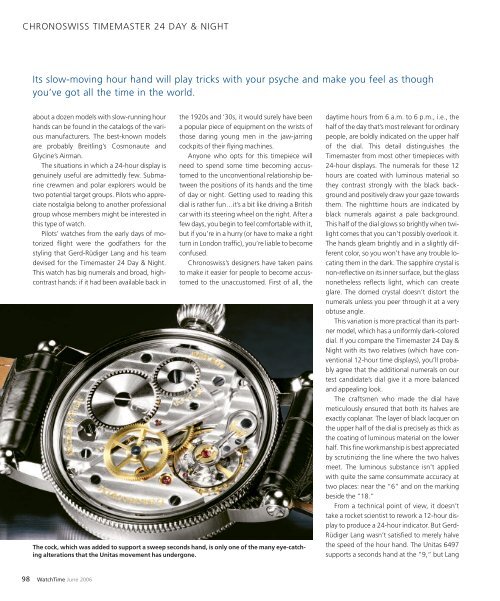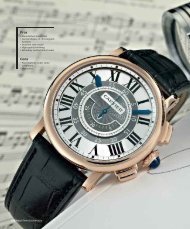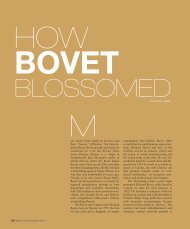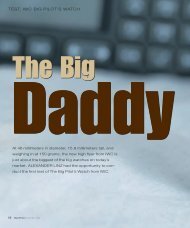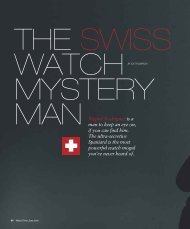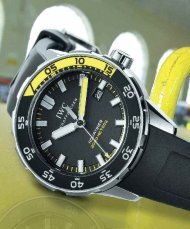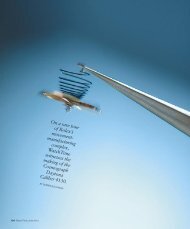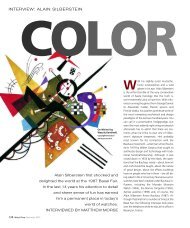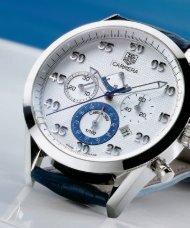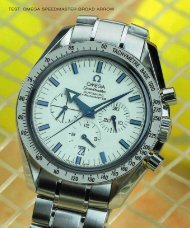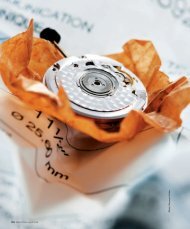WT_2006_03: CHRONOSWISS TIMEMASTER 24 DAY & NIGHT
WT_2006_03: CHRONOSWISS TIMEMASTER 24 DAY & NIGHT
WT_2006_03: CHRONOSWISS TIMEMASTER 24 DAY & NIGHT
Create successful ePaper yourself
Turn your PDF publications into a flip-book with our unique Google optimized e-Paper software.
<strong>CHRONOSWISS</strong> <strong>TIMEMASTER</strong> <strong>24</strong> <strong>DAY</strong> & <strong>NIGHT</strong>Its slow-moving hour hand will play tricks with your psyche and make you feel as thoughyou’ve got all the time in the world.about a dozen models with slow-running hourhands can be found in the catalogs of the variousmanufacturers. The best-known modelsare probably Breitling’s Cosmonaute andGlycine’s Airman.The situations in which a <strong>24</strong>-hour display isgenuinely useful are admittedly few. Submarinecrewmen and polar explorers would betwo potential target groups. Pilots who appreciatenostalgia belong to another professionalgroup whose members might be interested inthis type of watch.Pilots’ watches from the early days of motorizedflight were the godfathers for thestyling that Gerd-Rüdiger Lang and his teamdevised for the Timemaster <strong>24</strong> Day & Night.This watch has big numerals and broad, highcontrasthands: if it had been available back inthe 1920s and ‘30s, it would surely have beena popular piece of equipment on the wrists ofthose daring young men in the jaw-jarringcockpits of their flying machines.Anyone who opts for this timepiece willneed to spend some time becoming accustomedto the unconventional relationship betweenthe positions of its hands and the timeof day or night. Getting used to reading thisdial is rather fun…it’s a bit like driving a Britishcar with its steering wheel on the right. After afew days, you begin to feel comfortable with it,but if you’re in a hurry (or have to make a rightturn in London traffic), you’re liable to becomeconfused.Chronoswiss’s designers have taken painsto make it easier for people to become accustomedto the unaccustomed. First of all, theThe cock, which was added to support a sweep seconds hand, is only one of the many eye-catchingalterations that the Unitas movement has undergone.daytime hours from 6 a.m. to 6 p.m., i.e., thehalf of the day that’s most relevant for ordinarypeople, are boldly indicated on the upper halfof the dial. This detail distinguishes theTimemaster from most other timepieces with<strong>24</strong>-hour displays. The numerals for these 12hours are coated with luminous material sothey contrast strongly with the black backgroundand positively draw your gaze towardsthem. The nighttime hours are indicated byblack numerals against a pale background.This half of the dial glows so brightly when twilightcomes that you can’t possibly overlook it.The hands gleam brightly and in a slightly differentcolor, so you won’t have any trouble locatingthem in the dark. The sapphire crystal isnon-reflective on its inner surface, but the glassnonetheless reflects light, which can createglare. The domed crystal doesn’t distort thenumerals unless you peer through it at a veryobtuse angle.This variation is more practical than its partnermodel, which has a uniformly dark-coloreddial. If you compare the Timemaster <strong>24</strong> Day &Night with its two relatives (which have conventional12-hour time displays), you’ll probablyagree that the additional numerals on ourtest candidate’s dial give it a more balancedand appealing look.The craftsmen who made the dial havemeticulously ensured that both its halves areexactly coplanar. The layer of black lacquer onthe upper half of the dial is precisely as thick asthe coating of luminous material on the lowerhalf. This fine workmanship is best appreciatedby scrutinizing the line where the two halvesmeet. The luminous substance isn’t appliedwith quite the same consummate accuracy attwo places: near the “6” and on the markingbeside the “18.”From a technical point of view, it doesn’ttake a rocket scientist to rework a 12-hour displayto produce a <strong>24</strong>-hour indicator. But Gerd-Rüdiger Lang wasn’t satisfied to merely halvethe speed of the hour hand. The Unitas 6497supports a seconds hand at the “9,” but Lang98 WatchTime June <strong>2006</strong>


